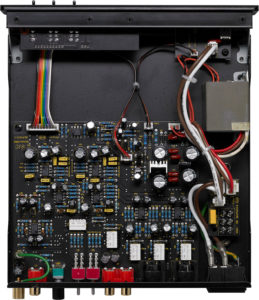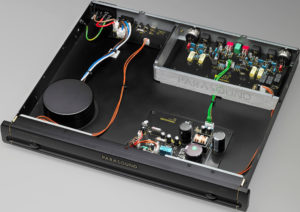I managed to pick up the Denon DP-47F locally off of Facebook Marketplace. It did come in handy, for just over half the price of the $599 XRM, a steal by any estimation, usually selling for double what I paid, so I felt from that vantage point they were on somewhat equal footing. The DP-47F with its Ortofon 2M Red was transformed. It went from being an adequate and a nice table to have, to one that I just wanted to keep on playing for hours on end. The gain settings for both MM (40dB /50dB) and MC (50dB / 60dB) admittedly are relatively sparse in comparison to other phono stages on the market, and this did trouble me at first, but then having jacked up gain up to 50dB the LP Gear T4P REFERENCE SERIES VL came into its own. The table made its way to me with a bog standard Universal Audio Technica P-Mount and while adequate, it left me wanting more. The XRM was making both me and the DP-47F smile.
I picked up a stack of used vinyl from my “supplier” and it didn’t dawn on me that several of the older classical recordings were Mono, so with there being a toggle on the front of the unit, I was listening to the music as intended.
From Parasound directly, speaking about the XRM:
‘A front panel input switch selects MM and MC input jacks. Each of these jacks has its own circuitry optimized for the cartridge type. This improves the signal-to-noise ratio and overall performance for MM and for both low-output and high-output MC cartridges. A bonus of having separate input jacks with their own circuits is the capability to connect two turntables (or two tonearms mounted on a single turntable). The Stereo/Mono switch combines L and R channels so users can optimize sound quality of mono LPs as well as reducing background noise on worn or poorly stamped pressings ….’
A rather succinct statement as to what is different and what makes the XRM unique. You would be hard-pressed to find these features in a similarly priced phono stage, if at all. This is what impresses me about Parasound. The team over there actually listens to and respects the needs and concerns of the audio consumer. I communicate with Richard Schram and Phil Jackson at Parasound. Phil and I talked at length at Capitol Audio Fest 2018 this past November about the XRM and why it had come to be. Analog enthusiasts/turntable fans are turning to more and more experimentation, whether it be stereo vs mono, moving magnet (mm) vs moving coil (mc) or, for the truly adventurous, two tonearms on a single table.
Bottom Line: If your turntable is basic or you are planning on acquiring a basic turntable and you want a standalone phono stage, then go with the ZPhono. If you are looking to start out with a basic turntable and upgrade later to something more substantial, then look no further than the ZPhono XRM.
All of the above can be applied to my bevy of turntables. However, two of them, the Denon DP-47F with Denon DL-103R Moving Coil cartridge and the VPI Prime Scout fitted with a Soundsmith Carmen, could do better. These tables were held back by the ZPhono XRM to the extent that, given their cost and the lengths taken to acquire them, I sensed that I was not hearing all that I could out of them. Pairing is everything, so enter Parasound’s JC3 Jr., roughly 2/3 the features of the acclaimed JC3+ for just about 1/2 the price. Who can argue with that proposition?
Moving up from the XRM to the JC3 Jr. means not only tripling the cost but also re-examining your entire system, or in my case, systems. The JC3 Jr. is a totally different animal, its lineage far more refined, and to better understand the unit it must be looked upon as a descendant of the much acclaimed JC3 and the more recently released JC3+.
Getting back to that proposition, Richard Schram, Parasound CEO and Founder, is making you an offer you can almost not refuse. To assume that numerous corners were cut on the JC3 Jr. in order to deliver on the quality, features and price would be a mistake. I popped the lid on the unit, as I do with just about every piece of gear that comes before me. I’m fully aware that pictures are worth a thousand … but I just have to see for myself. Comparing the innards of the JC3+ and JC3 Jr., Parasound’s engineering team employ a single board behind a single shield in order to house the JC3 Jr.’s gain and equalization circuitry for the two channels, whereas the JC3+ employs both separate boards and shielding. The JC3 Jr. makes use of a shared power supply while the JC3+ is dual-mono.
Some of the mystery solved with respect to size and weight, and I reckon that the powers that be made some informed decisions, a risk-reward analysis, of what could be cut back that would not negatively affect the JC3 Jr.’s sonic quality. From what I could make out exploring their designs and researching the JC3+, John Curl’s familiar and trusted RIAA EQ circuit with all its trimmings made the cut. On paper it would seem that a fair bit did not, but that too would be incorrect.
The JC3 Jr., in the JC3+’s shadow, employs the same toroidal power supply, the same ‘high speed/soft recovery’ bridge diodes, and the same inductors, designed to eliminate background noise. I had to wonder, what with using above-standard REL capacitors, Vishay-Dale resistors, and high-quality Vampire 24k gold plated RCA jacks and Neutrik XLR connectors, how the target price point could still be met.
A switchable set of RCA jacks, between MM and MC, keep things simple. While the MM is fixed at 47k Ohms, the MC, when toggled, can be adjusted continually via a rotating knob for load values between 50 and 550 ohms. Yet, something else borrowed from its elder sibling. Connected via RCA we’re looking at gain settings of 40dB, 50dB and 60dB; from the balanced outputs, these will be effectively 46dB, 56dB and 66dB.
This past year I have added a number of staff members to my New Album Releases (NAR) Facebook group. All of them were/are Oberlin Music Conservatory students and in this short amount of time I have learned greatly from them, specifically about the characteristics and terms used to describe quality recorded sound: overall bandwidth, spectral balance, auditory image, spatial impression (reverberation and time-based effects), dynamic range, noise and distortion.
Listening to albums on both the Denon DP-47F, now outfitted with the Denon moving coil DL-103R, and the VPI Prime Scout with its Soundsmith Carmen, made me re-visit records that were pushed to the back of the queue. Recordings that I judged to be merely adequate and listenable were now being bumped to the front of the queue. So many symphonic/orchestral pieces where I thought strings and woodwinds were being overshadowed now took on a new light. The DP-47F benefitted greatly when I added the DL-103R to the mix, and connecting it to the JC3 Jr. took it far beyond its original humble intentions.
Let’s face it, the Denon DP-47F turntable is a fully automatic computerized turntable weighing less than it looks like it should. I acquired the turntable locally because I wanted something nicer for those times when I was too lazy, too tired, or too inebriated to get up and minister to the beast. The JC3 Jr. laid waste to those plans, as now I cannot wait to play another album.
Ravi Shankar and Philip Glass collaborated on the 1990 Passages album, and I have it on vinyl, cd and digital files. In my estimation this is a recording that meets at the intersection of Auditory Image, Spatial Impression and Dynamic Range. What a glorious place to find oneself, and in comparing the three, with the aid of the JC3 Jr.and the Denon and VPI turntables, I’m also finding perfection in the imperfections that are inherent in analog playback. For this phono stage to be so transformative, for it to make so clear and so evident the modulations between Shankar’s introspective Eastern influenced music and Glass’s classical minimalism, makes me want to explore what more is indeed possible, what more can be extracted in the analog process.
Parasound’s ZPhono and ZPhono XRM are not in the same league as the JC3 Jr. That was never the intention, but with these three and the JC3+, Parasound has managed to cover more than a few bases. With something to offer at each price point and level of sophistication, the tradeoffs from one model to the next are expertly measured with respect to price, performance and features.
Specifications of all three products:
Copy editor: Dan Rubin
- ← Previous page
- (Page 2 of 2)







I’m also in Columbus Ohio and into HiFi. Do you have any favorite local dealers or shops?
Excellent review. Thanks for making it more difficult to decide between these two models!
I compared the XRM to the JC3 JR. They basically sounded the same. The difference however was the improved dynamics on the JC3 JR. Vocals, guitars, and keys popped a little more. As a result there is improved front to back depth of the music and the bass is a little tighter. It was hard for me to notice the differences initially because they have the same clean and quiet character. The difference is about 7% improvement in dynamics. You have to focus on it to hear it. Once you do, its more obvious. But for the general public, the XRM is just fine/
One more thing, one more difference was the bass being tighter on the JC3 JR. On the XRM it was more rounded and not as clear. This is on a Rega 6 turntable with a MC cartridge. On a less expensive turntable with a MM cartridge, you probably would not notice the differences as much.